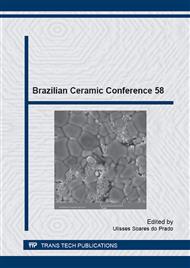p.373
p.378
p.384
p.393
p.399
p.405
p.411
p.419
p.425
Study of Sintering Behavior of Ceramic Composite Al2O3-TiO2 Rare Reinforcing with La2O3 Possible Application as Ceramic Cutting Tools
Abstract:
In this work, composite ceramic was produced to base Al2O3 reinforced with 35% weight TiO2 and variation 0-2% La2O3, were evaluated properties to study their microstructural characteristic and mechanical properties as applicable cutting tools. The ceramic composites were produced by thermo-mechanical process. It was observed from the results of XRD after sintering no new phase is formed, besides the characteristics of the precursor oxides. According to the result of particle size analysis before and 24 hours after milling, there was a reduction of the average diameter of agglomerate 95.25% which is suitable to assist sintering of the composite, because this reduction increases the reaction rate the raw material during firing. At microdurezavickers test it was observed that the sample with 1.5% La2O3 showed better hardness results.
Info:
Periodical:
Pages:
399-404
Citation:
Online since:
June 2015
Keywords:
Price:
Сopyright:
© 2015 Trans Tech Publications Ltd. All Rights Reserved
Share:
Citation:


